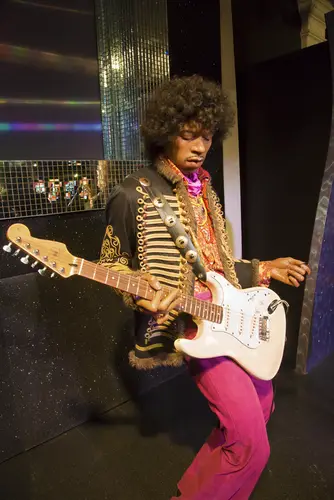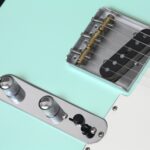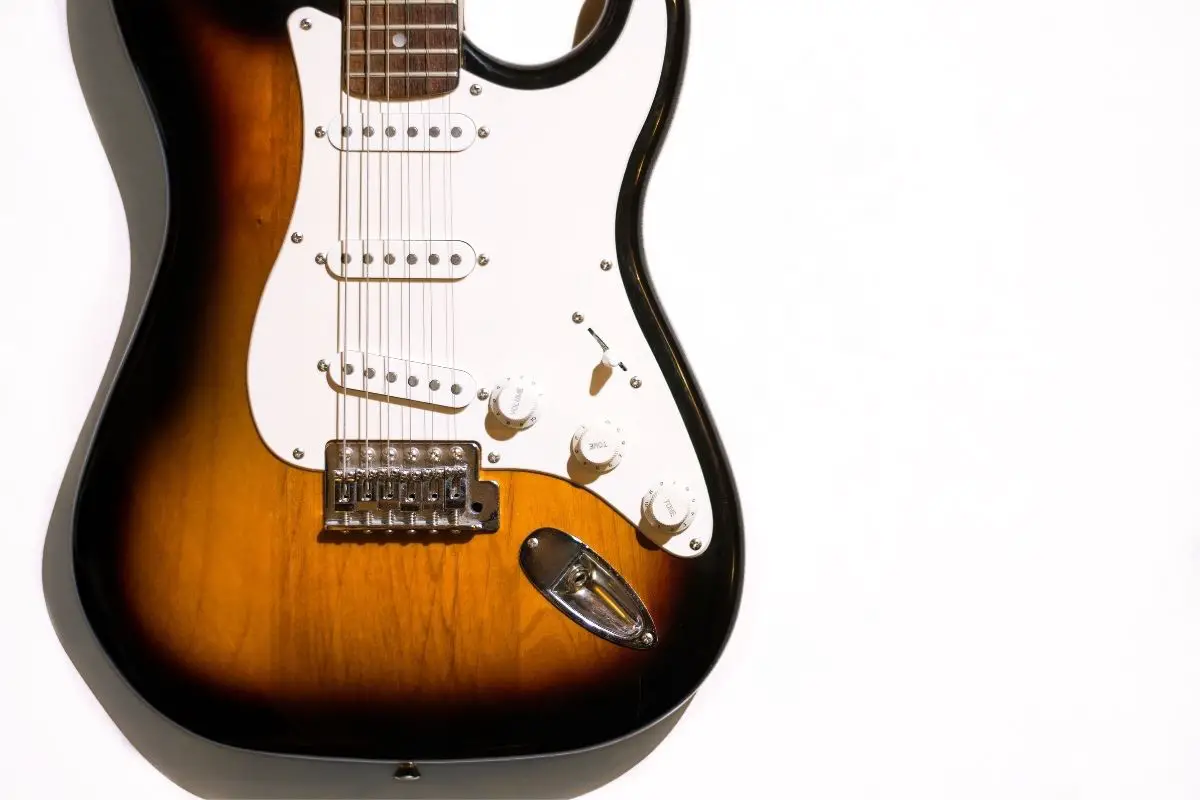Jimi Hendrix, one of the most influential guitarists of all time, was naturally a left-handed guitar player. His unique style and approach to the instrument were significantly influenced by his left-handedness.
As Hendrix’s father frequently forced him to play right-handed guitar, he adapted by flipping over and restringing standard right-handed Fender Stratocasters instead of seeking out less-available left-handed guitar models.
This unconventional setup resulted in altered string tension and pickup locations, which contributed to Hendrix’s distinctive sound. This level of ambidexterity allowed Jimi Hendrix to integrate the actions of his left and right hands seamlessly while playing, a factor that played a significant role in his virtuosity and success as a guitarist.
Key Takeaways on Why Did Jimi Hendrix Play Left Handed?
- Jimi Hendrix was a naturally left-handed guitarist who played upside-down restrung right-handed Fender Stratocasters
- His ambidexterity allowed him to seamlessly integrate the actions of both hands, contributing to his unique playing style
- Hendrix’s left-handedness significantly influenced his sound, approach, and lasting impact on the world of music
See these other top picks in this category:
- Why Did Jimi Hendrix Play Upside Down?
- How Did Jimi Hendrix Tune His Guitar?
- How Did Jimi Hendrix Dress?
Jimi Hendrix: The Left-Handed Enigma
Jimi Hendrix, one of the most influential guitarists of all time, was known for his unique playing style. One of the factors contributing to his distinct sound was his left-handedness. Despite being naturally right-handed, Hendrix chose to play guitar left-handed, flipping over and restringing standard right-handed Fender Stratocasters.
Jimi Hendrix’s decision to play left-handed wasn’t merely a matter of preference; it had a significant impact on his guitar’s sound. By playing left-handed on a right-handed guitar, the string tension and microphone location were altered, which in turn produced Hendrix’s signature tones.
Furthermore, his ambidexterity allowed Hendrix to perform complex and innovative techniques, such as playing with both hands on the fretboard, which greatly contributed to his virtuosity.
This combination of left-handedness and ambidexterity provided Hendrix with an unparalleled edge over other guitarists. It allowed him to create a style that was entirely his own, blending traditional playing techniques with his natural ability to switch hands effortlessly.
This versatility enabled Hendrix to experiment with various guitar setups and custom string gauges, ultimately revolutionizing the world of guitar playing.
Jimi Hendrix’s unique approach to the guitar and his decision to play left-handed had a profound impact on the music he created. By embracing his ambidexterity and exploiting the benefits it offered, Hendrix was able to create groundbreaking sounds and leave an indelible mark on modern music.
Hendrix’s Guitar Choice and Setup
The Upside Down Stratocaster
Jimi Hendrix, a left-handed guitarist, is well known for his preference for the Fender Stratocaster. In a time when left-handed guitars were not readily available, Hendrix chose to play a right-handed Stratocaster upside down, with the neck held in his right hand and strummed using his left hand. This setup created a unique orientation of the strings and pickups, contributing to his distinct sound.
This iconic guitar choice became synonymous with Hendrix’s playing style, and the white, right-handed Stratocaster strung upside down remained his favorite setup throughout his short-lived but remarkable career.
Effects of Restringing
When Hendrix restrung his right-handed Stratocaster, he essentially reversed the string order, with the low E string closest to his head and the high E string closest to the floor. This inversion had several effects on the guitar’s setup and sound:
- The reversed string order meant that the guitar’s bridge pickup was also inverted, affecting its angle and contributing to the unique Hendrix tone.
- The reversed strings also altered the tension of each string, since they were not designed to be played in this configuration. This may have contributed to Hendrix’s expressive vibrato and string bending techniques.
- The position of the volume and tone controls on the Stratocaster was also altered in this setup, enabling Hendrix to easily access and manipulate them with his strumming hand.
Jimi Hendrix’s choice to play a restrung, upside-down Fender Stratocaster was not only a practical solution to the limited availability of left-handed guitars but also a significant contributor to his innovative, boundary-breaking sound.
Influence on Hendrix’s Unique Style and Sound
Guitar Techniques and Tuning
Jimi Hendrix’s unique style and sound emerged from his remarkable technique and approach to tuning. He often tuned his guitar down half a step, allowing him to achieve heavier and fuller tones.
Hendrix’s ability to seamlessly blend blues, rock, and psychedelic elements relied heavily on his use of standard tuning, while also incorporating alternate tunings to create an otherworldly sound.
One of the key aspects of his playing was how he utilized the guitar’s E string. Hendrix often bent the E string to create emotional vibrations in his solos and riffs.
This technique, combined with careful use of chord shapes, allowed him to develop his iconic sound. His mastery of the guitar included profound understanding of various pickups, enabling him to control and adjust tone and sound with precision.
In addition, Hendrix’s extraordinary command of techniques such as hammer-ons, pull-offs, and vibratos produced a melodious and expressive style that has influenced countless musicians since. His signature bends and fluid chord progressions further emphasized the depth and sophistication of his talent.
The Lefty Advantage
One of the most distinctive features of Jimi Hendrix’s playing was his decision to play left-handed. Although a natural left-hander, Hendrix played with a right-handed Fender Stratocaster flipped upside down and restrung for his left hand. This unconventional choice had a profound impact on his unique style and sound.
By playing left-handed, Hendrix had the ability to access the higher strings more easily, which allowed more aggressive and expressive bendings and vibratos that characterized his playing.
Moreover, the reversed alignment of the pickups on his Stratocaster made a significant difference in tone, contributing to the unmistakable sound that remains synonymous with his name.
Hendrix’s lefty approach also allowed him to devise chord shapes and fingerings that most right-handed guitarists would find challenging, complementing his boundary-pushing techniques and further enhancing his signature style. Through these innovative choices, Jimi Hendrix revolutionized guitar playing, leaving an indelible impact on music history.
Left-Handedness in Popular Music
Other Left-Handed Guitarists
Left-handed guitarists have made a significant impact on popular music. Some of the most famous left-handed guitarists, aside from Jimi Hendrix, include Kurt Cobain, the frontman of Nirvana, and Paul McCartney from The Beatles. Both of these musicians are known for their distinctive playing styles and contributions to their respective genres.
Another notable left-handed guitarist is blues legend Albert King, who played a right-handed guitar upside-down without restringing it. This unique approach to guitar playing produces a distinct sound, setting him apart from other blues musicians.
Multitalented and Ambidextrous Musicians
In addition to left-handed guitarists, there are many multi talented musicians who excel at multiple instruments, adapting to various musical settings with ease. Phil Collins, for example, is a renowned drummer and singer, as well as an accomplished pianist and guitarist.
Furthermore, some musicians are not strictly left-handed but possess a remarkable ability to play instruments ambidextrously. These ambidextrous musicians can switch between left-and right-handed playing, showcasing exceptional dexterity and skill. Jimi Hendrix was known to be ambidextrous, which contributed significantly to his inventive and groundbreaking guitar techniques.
Left-handedness and ambidexterity in popular music have led to some of the most unique and influential musicians in history. These exceptional artists have demonstrated that embracing one’s natural inclinations can result in groundbreaking and distinctive contributions to the world of music.
The Hendrix Effect: Legacy and Influence
Jimi Hendrix, a revolutionary musician, left an enduring impact on the music industry primarily with his exceptional blend of blues and rock. As the frontman for the Jimi Hendrix Experience, he played memorable gigs and released iconic hits like “Purple Haze”. Hendrix’s distinct sound influenced major rock artists for generations to come.
Apart from his music, Jimi Hendrix was also known for playing left-handed, which was uncommon amongst guitarists at the time. As a southpaw, Hendrix added a unique touch to his performances, enhancing his talents and overall prowess.
This aspect also contributed to his exceptional guitar skills, further solidifying his reputation in rock and roll history.
Throughout his career, Hendrix demonstrated remarkable versatility by seamlessly merging blues and rock elements, attracting fans from both genres. His live performances, especially at major festivals like Monterey, showcased unforgettable stage presence and raw energy that captivated audiences worldwide.
Jimi’s innovative guitar playing techniques and signature effects, such as wah, feedback, and fuzz, continue to be revered by contemporary musicians today.
His aptitude for playing, singing, and dancing simultaneously showcased his incredible mastery of both his craft and his instrument. As a result, Hendrix earned a distinguished spot on Rolling Stone’s list of the greatest guitarists of all time.
The lasting legacy of Jimi Hendrix extends beyond his music to his unique playing style as a left-handed guitarist. With significant contributions to both the blues and rock genres, Jimi Hendrix left an indelible impact on the world of rock and roll that continues to inspire musicians and delight fans even 50 years after his untimely death.
Frequently Asked Questions

Did Hendrix play left-handed due to comfort?
Yes, Hendrix played left-handed primarily due to comfort. He was naturally left-handed, which made it more convenient for him to play the guitar in that orientation. Hendrix preferred playing right-handed Fender Stratocasters upside down and restrung for left-handed playing.
Was Hendrix naturally left-handed or self-taught?
Hendrix was naturally left-handed, but he had to learn to play a right-handed guitar in order to master a left-handed guitar in the 1960s. His ambidexterity allowed him to use both his right and left hands effectively while playing the guitar.
What challenges did Hendrix face as a left-handed guitarist?
As a left-handed guitarist, Hendrix faced difficulties in finding left-handed guitars, leading him to restring and modify right-handed instruments instead. Additionally, he faced criticism from his father when he was younger for playing left-handed.
How did Hendrix’s left-handed playing affect his guitar setup?
Hendrix’s left-handed playing significantly impacted his guitar setup. By flipping over and restringing right-handed Fender Stratocasters, he altered the string tension and microphone location, creating a unique sound and playing style.
Did playing left-handed contribute to Hendrix’s unique sound?
Yes, playing left-handed contributed to Hendrix’s unique sound. The modifications he made to his guitars due to his left-handed playing, such as altered string tension and microphone location, resulted in a distinctive sound that became one of his trademark.
Can you name some other famous left-handed guitarists?
Some other famous left-handed guitarists include Paul McCartney, Tony Iommi of Black Sabbath, Kurt Cobain of Nirvana, and Albert King, all of whom also contributed significantly to the world of music through their unique playing styles and sounds.

My name is Howard Matthews and I have been playing the guitar since I was knee-high. My parents like to joke that I was pulling the strings even before I was born. In fact, one of my earliest memories is sitting on the couch with my dad’s guitar, wreaking havoc on the chords.
Now, 40 years later, I can attest that I play them much better than I did back then. I have followed in the footsteps of both my parents – much to their delight – and have been the main guitarist in my band for the best part of three decades.
Music has always been my passion, and until recently my life has been so consumed with it that I haven’t had a moment to have a breath (and I wouldn’t have it any other way)!








